engine JEEP WRANGLER 2010 JK / 3.G Repair Manual
[x] Cancel search | Manufacturer: JEEP, Model Year: 2010, Model line: WRANGLER, Model: JEEP WRANGLER 2010 JK / 3.GPages: 554, PDF Size: 10.76 MB
Page 412 of 554
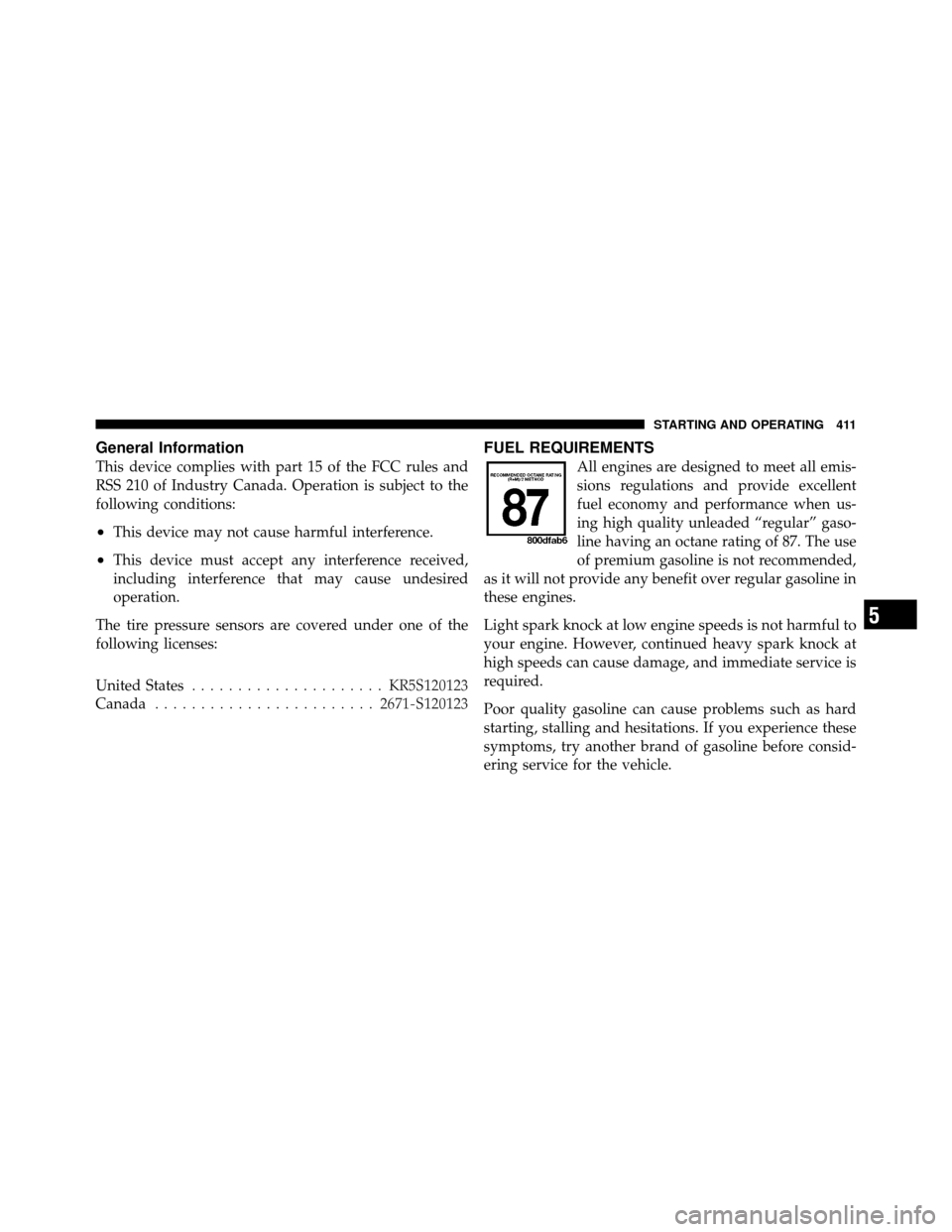
General Information
This device complies with part 15 of the FCC rules and
RSS 210 of Industry Canada. Operation is subject to the
following conditions:
•This device may not cause harmful interference.
•This device must accept any interference received,
including interference that may cause undesired
operation.
The tire pressure sensors are covered under one of the
following licenses:
United States ..................... KR5S120123
Canada ........................ 2671-S120123
FUEL REQUIREMENTS
All engines are designed to meet all emis-
sions regulations and provide excellent
fuel economy and performance when us-
ing high quality unleaded “regular” gaso-
line having an octane rating of 87. The use
of premium gasoline is not recommended,
as it will not provide any benefit over regular gasoline in
these engines.
Light spark knock at low engine speeds is not harmful to
your engine. However, continued heavy spark knock at
high speeds can cause damage, and immediate service is
required.
Poor quality gasoline can cause problems such as hard
starting, stalling and hesitations. If you experience these
symptoms, try another brand of gasoline before consid-
ering service for the vehicle.
5
STARTING AND OPERATING 411
Page 413 of 554
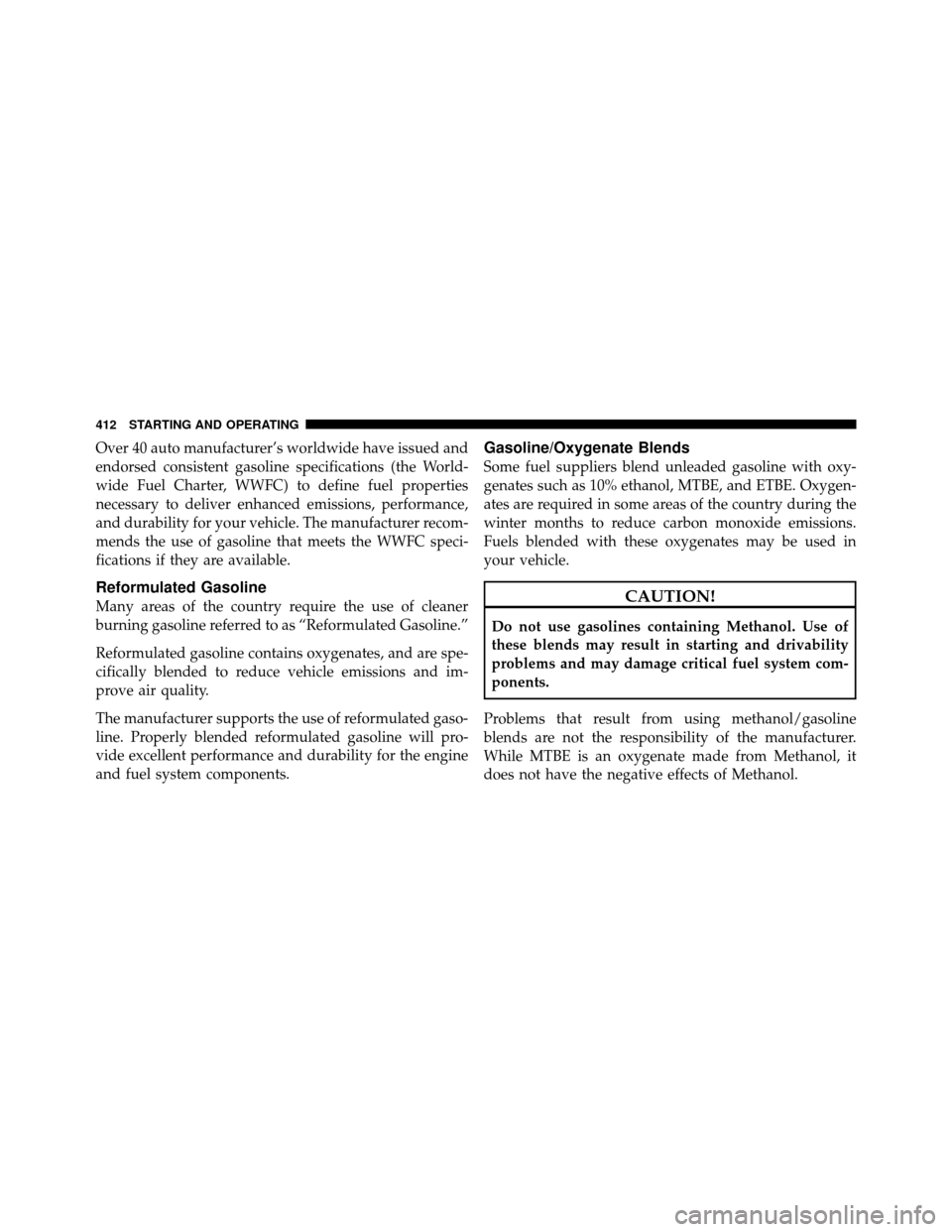
Over 40 auto manufacturer’s worldwide have issued and
endorsed consistent gasoline specifications (the World-
wide Fuel Charter, WWFC) to define fuel properties
necessary to deliver enhanced emissions, performance,
and durability for your vehicle. The manufacturer recom-
mends the use of gasoline that meets the WWFC speci-
fications if they are available.
Reformulated Gasoline
Many areas of the country require the use of cleaner
burning gasoline referred to as “Reformulated Gasoline.”
Reformulated gasoline contains oxygenates, and are spe-
cifically blended to reduce vehicle emissions and im-
prove air quality.
The manufacturer supports the use of reformulated gaso-
line. Properly blended reformulated gasoline will pro-
vide excellent performance and durability for the engine
and fuel system components.
Gasoline/Oxygenate Blends
Some fuel suppliers blend unleaded gasoline with oxy-
genates such as 10% ethanol, MTBE, and ETBE. Oxygen-
ates are required in some areas of the country during the
winter months to reduce carbon monoxide emissions.
Fuels blended with these oxygenates may be used in
your vehicle.
CAUTION!
Do not use gasolines containing Methanol. Use of
these blends may result in starting and drivability
problems and may damage critical fuel system com-
ponents.
Problems that result from using methanol/gasoline
blends are not the responsibility of the manufacturer.
While MTBE is an oxygenate made from Methanol, it
does not have the negative effects of Methanol.
412 STARTING AND OPERATING
Page 414 of 554
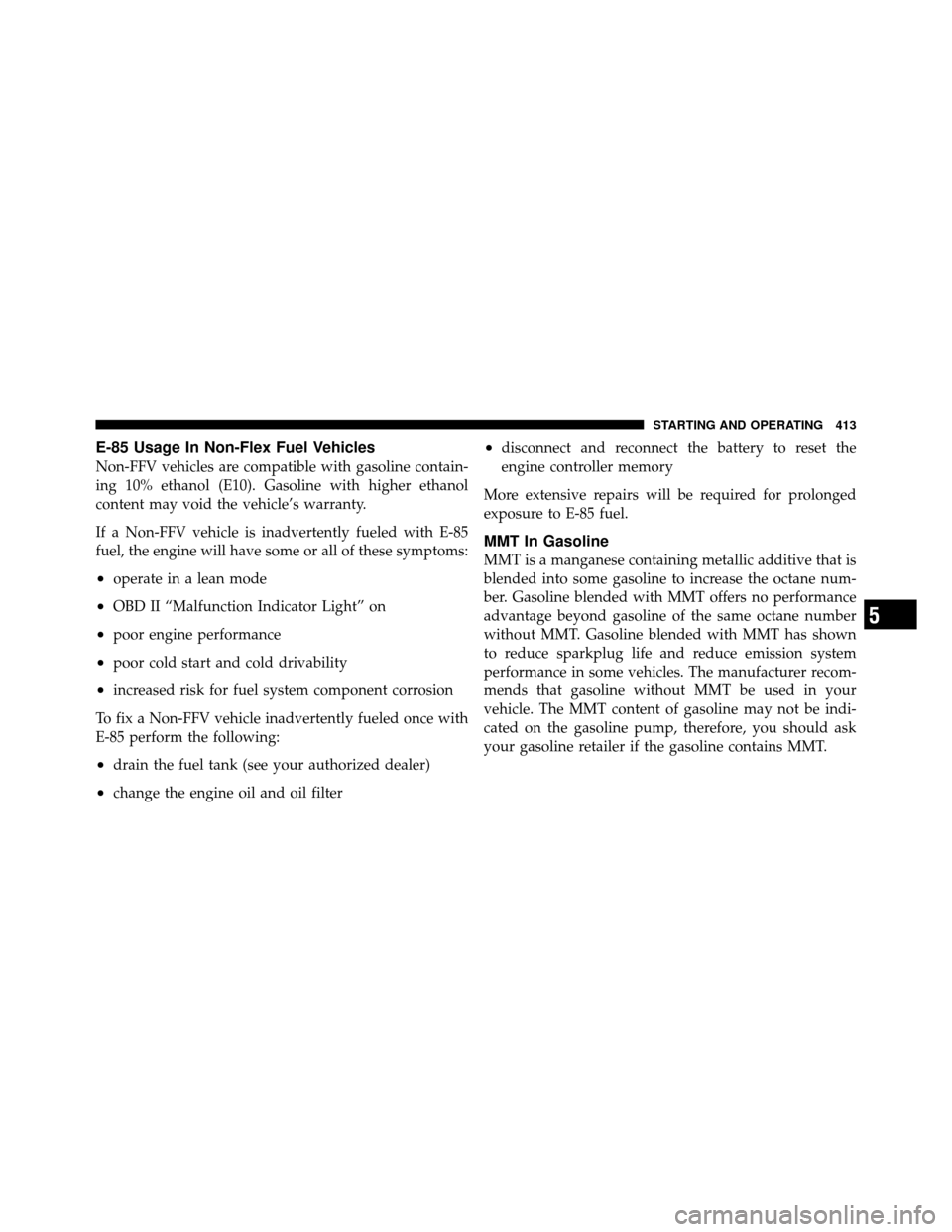
E-85 Usage In Non-Flex Fuel Vehicles
Non-FFV vehicles are compatible with gasoline contain-
ing 10% ethanol (E10). Gasoline with higher ethanol
content may void the vehicle’s warranty.
If a Non-FFV vehicle is inadvertently fueled with E-85
fuel, the engine will have some or all of these symptoms:
•operate in a lean mode
•OBD II “Malfunction Indicator Light” on
•poor engine performance
•poor cold start and cold drivability
•increased risk for fuel system component corrosion
To fix a Non-FFV vehicle inadvertently fueled once with
E-85 perform the following:
•drain the fuel tank (see your authorized dealer)
•change the engine oil and oil filter
•disconnect and reconnect the battery to reset the
engine controller memory
More extensive repairs will be required for prolonged
exposure to E-85 fuel.
MMT In Gasoline
MMT is a manganese containing metallic additive that is
blended into some gasoline to increase the octane num-
ber. Gasoline blended with MMT offers no performance
advantage beyond gasoline of the same octane number
without MMT. Gasoline blended with MMT has shown
to reduce sparkplug life and reduce emission system
performance in some vehicles. The manufacturer recom-
mends that gasoline without MMT be used in your
vehicle. The MMT content of gasoline may not be indi-
cated on the gasoline pump, therefore, you should ask
your gasoline retailer if the gasoline contains MMT.
5
STARTING AND OPERATING 413
Page 415 of 554
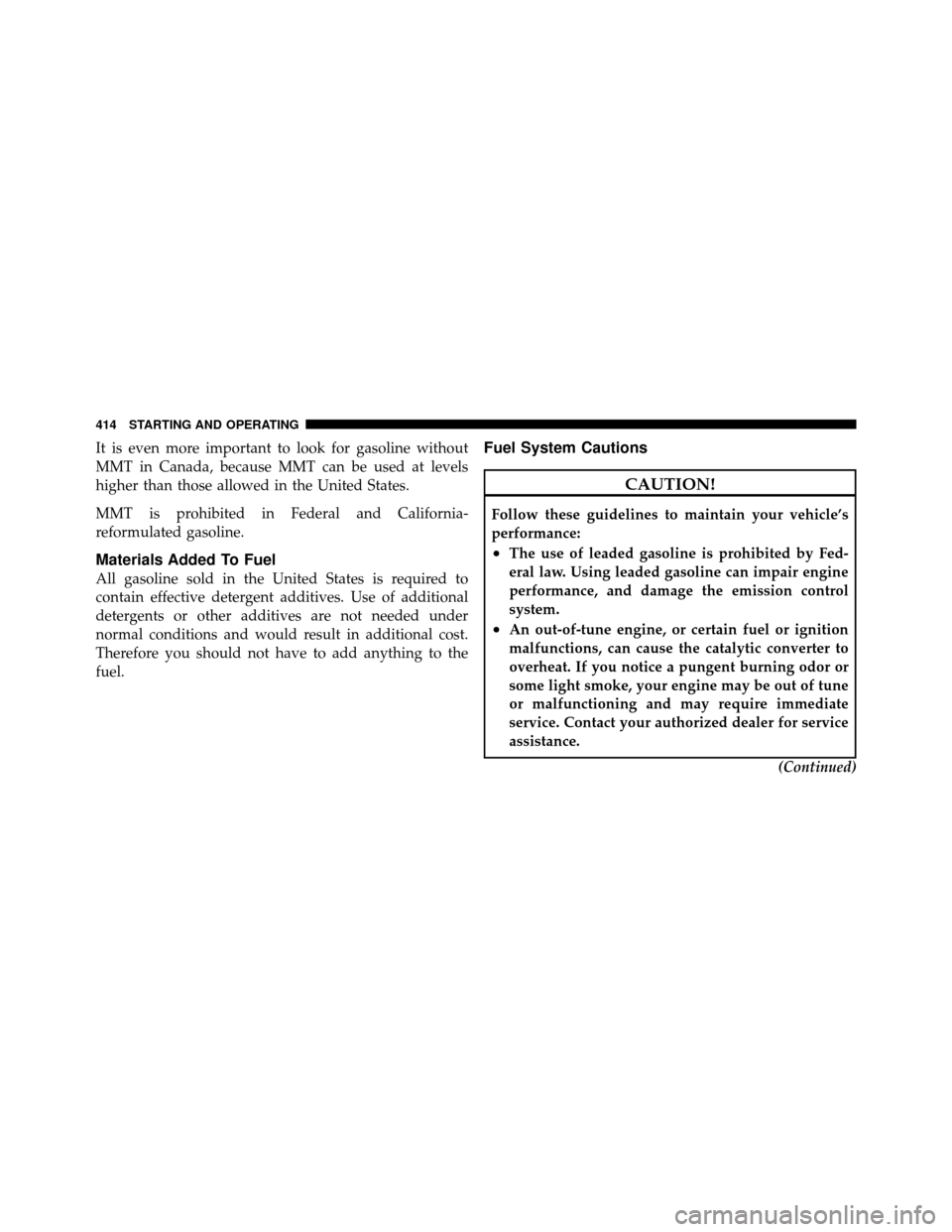
It is even more important to look for gasoline without
MMT in Canada, because MMT can be used at levels
higher than those allowed in the United States.
MMT is prohibited in Federal and California-
reformulated gasoline.
Materials Added To Fuel
All gasoline sold in the United States is required to
contain effective detergent additives. Use of additional
detergents or other additives are not needed under
normal conditions and would result in additional cost.
Therefore you should not have to add anything to the
fuel.
Fuel System Cautions
CAUTION!
Follow these guidelines to maintain your vehicle’s
performance:
•The use of leaded gasoline is prohibited by Fed-
eral law. Using leaded gasoline can impair engine
performance, and damage the emission control
system.
•An out-of-tune engine, or certain fuel or ignition
malfunctions, can cause the catalytic converter to
overheat. If you notice a pungent burning odor or
some light smoke, your engine may be out of tune
or malfunctioning and may require immediate
service. Contact your authorized dealer for service
assistance.(Continued)
414 STARTING AND OPERATING
Page 416 of 554
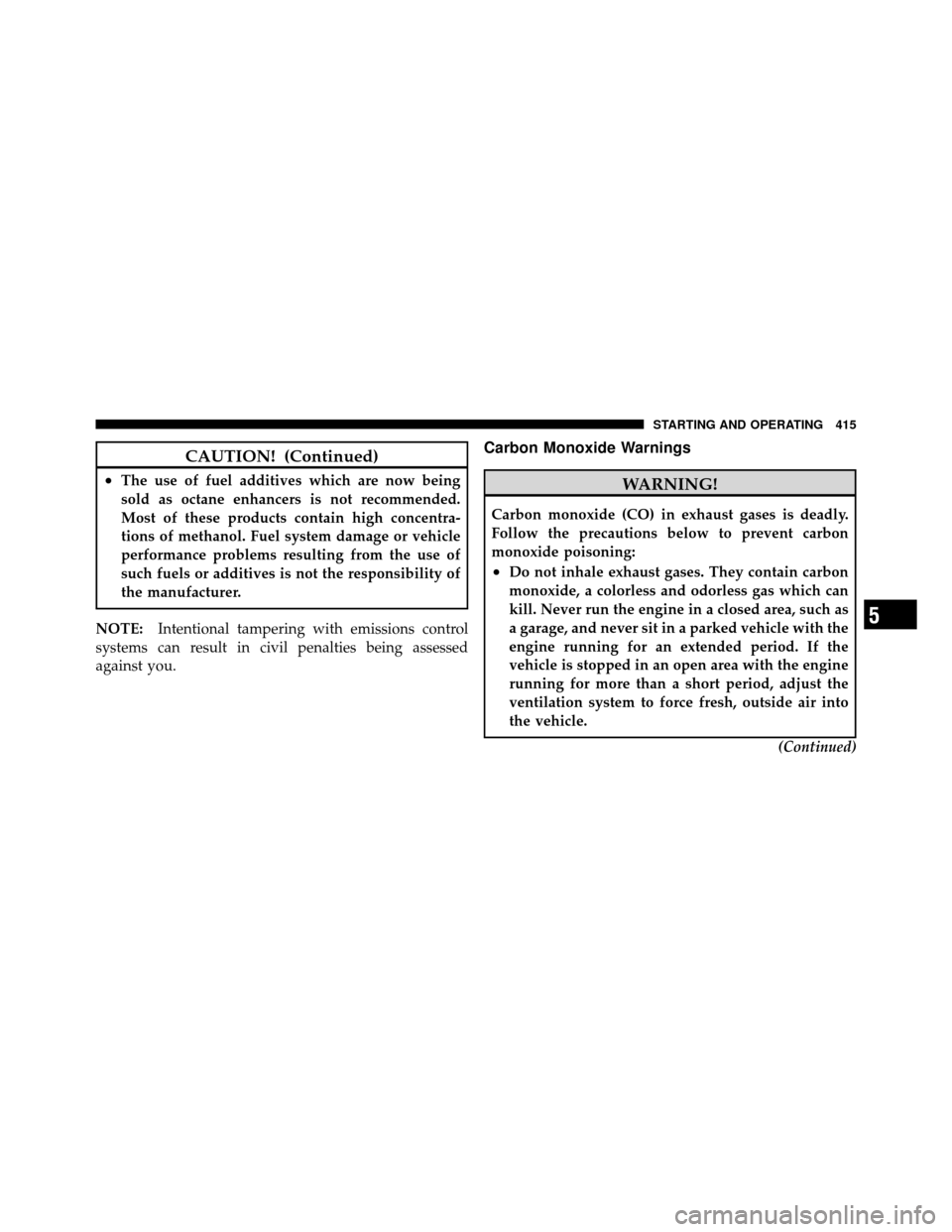
CAUTION! (Continued)
•The use of fuel additives which are now being
sold as octane enhancers is not recommended.
Most of these products contain high concentra-
tions of methanol. Fuel system damage or vehicle
performance problems resulting from the use of
such fuels or additives is not the responsibility of
the manufacturer.
NOTE: Intentional tampering with emissions control
systems can result in civil penalties being assessed
against you.
Carbon Monoxide Warnings
WARNING!
Carbon monoxide (CO) in exhaust gases is deadly.
Follow the precautions below to prevent carbon
monoxide poisoning:
•Do not inhale exhaust gases. They contain carbon
monoxide, a colorless and odorless gas which can
kill. Never run the engine in a closed area, such as
a garage, and never sit in a parked vehicle with the
engine running for an extended period. If the
vehicle is stopped in an open area with the engine
running for more than a short period, adjust the
ventilation system to force fresh, outside air into
the vehicle.
(Continued)
5
STARTING AND OPERATING 415
Page 418 of 554
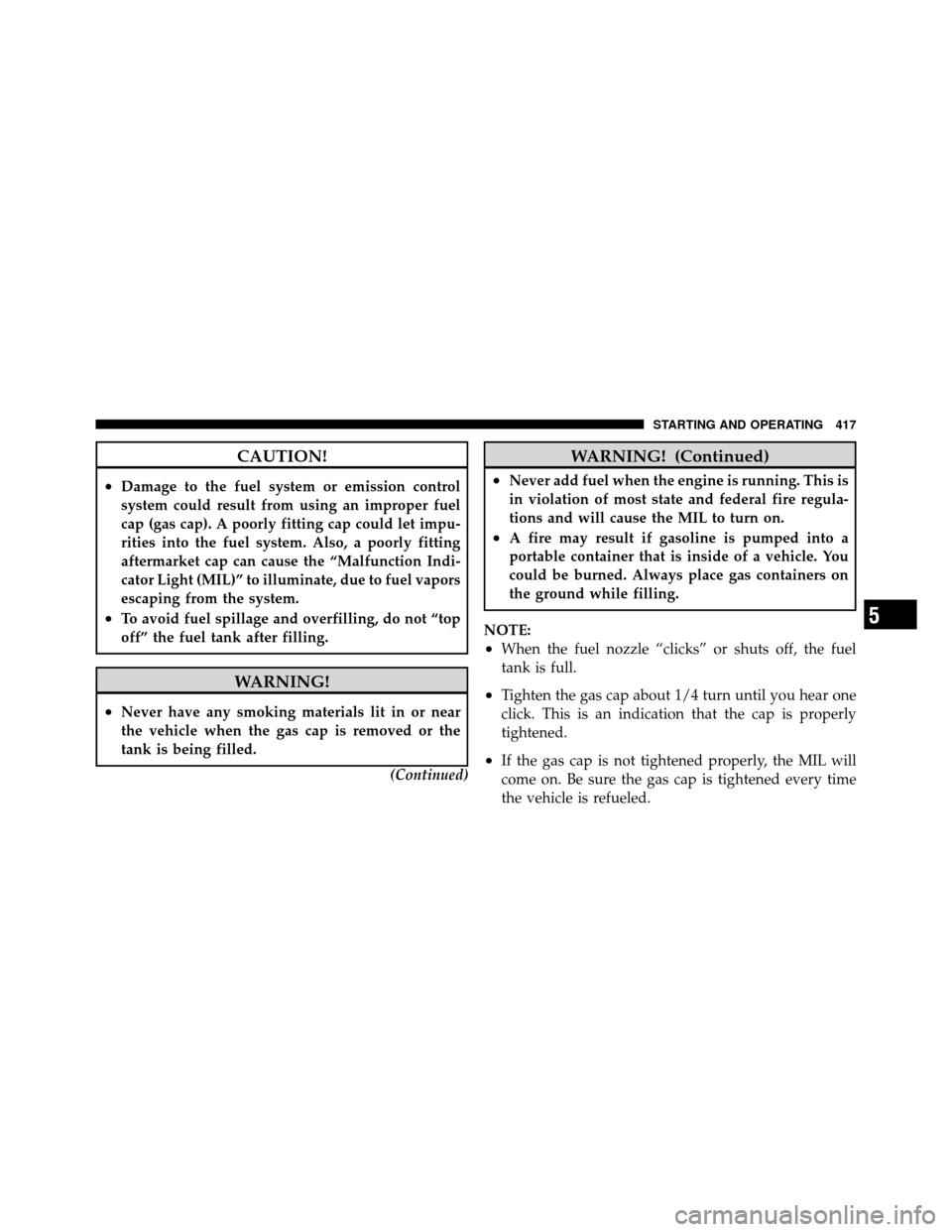
CAUTION!
•Damage to the fuel system or emission control
system could result from using an improper fuel
cap (gas cap). A poorly fitting cap could let impu-
rities into the fuel system. Also, a poorly fitting
aftermarket cap can cause the “Malfunction Indi-
cator Light (MIL)” to illuminate, due to fuel vapors
escaping from the system.
•To avoid fuel spillage and overfilling, do not “top
off” the fuel tank after filling.
WARNING!
•Never have any smoking materials lit in or near
the vehicle when the gas cap is removed or the
tank is being filled.(Continued)
WARNING! (Continued)
•Never add fuel when the engine is running. This is
in violation of most state and federal fire regula-
tions and will cause the MIL to turn on.
•A fire may result if gasoline is pumped into a
portable container that is inside of a vehicle. You
could be burned. Always place gas containers on
the ground while filling.
NOTE:
•When the fuel nozzle “clicks” or shuts off, the fuel
tank is full.
•Tighten the gas cap about 1/4 turn until you hear one
click. This is an indication that the cap is properly
tightened.
•If the gas cap is not tightened properly, the MIL will
come on. Be sure the gas cap is tightened every time
the vehicle is refueled.
5
STARTING AND OPERATING 417
Page 426 of 554
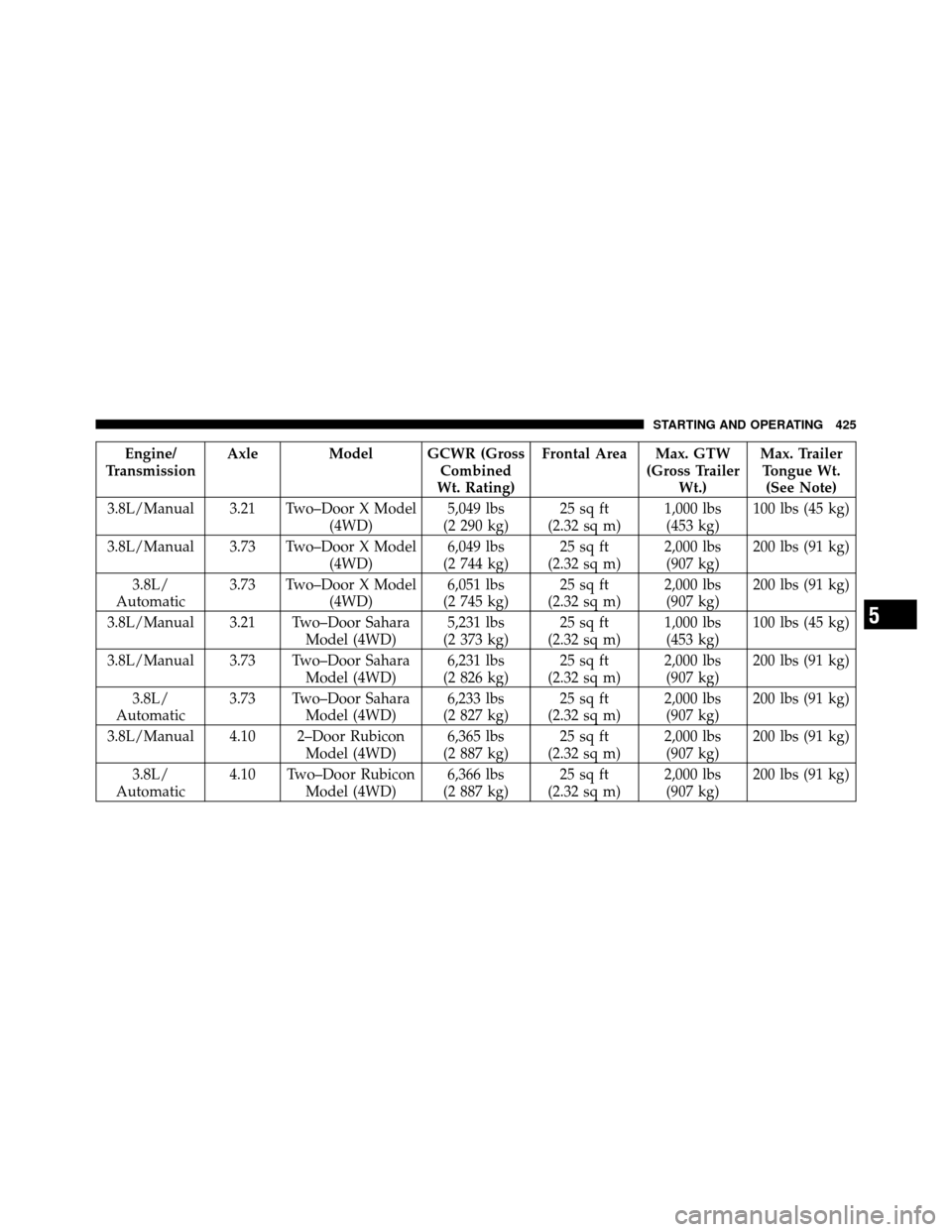
Engine/
Transmission Axle Model GCWR (Gross
Combined
Wt. Rating) Frontal Area Max. GTW
(Gross TrailerWt.) Max. Trailer
Tongue Wt. (See Note)
3.8L/Manual 3.21 Two–Door X Model (4WD)5,049 lbs
(2 290 kg) 25 sq ft
(2.32 sq m) 1,000 lbs
(453 kg) 100 lbs (45 kg)
3.8L/Manual 3.73 Two–Door X Model (4WD)6,049 lbs
(2 744 kg) 25 sq ft
(2.32 sq m) 2,000 lbs
(907 kg) 200 lbs (91 kg)
3.8L/
Automatic 3.73 Two–Door X Model
(4WD) 6,051 lbs
(2 745 kg) 25 sq ft
(2.32 sq m) 2,000 lbs
(907 kg) 200 lbs (91 kg)
3.8L/Manual 3.21 Two–Door Sahara Model (4WD)5,231 lbs
(2 373 kg) 25 sq ft
(2.32 sq m) 1,000 lbs
(453 kg) 100 lbs (45 kg)
3.8L/Manual 3.73 Two–Door Sahara Model (4WD)6,231 lbs
(2 826 kg) 25 sq ft
(2.32 sq m) 2,000 lbs
(907 kg) 200 lbs (91 kg)
3.8L/
Automatic 3.73 Two–Door Sahara
Model (4WD) 6,233 lbs
(2 827 kg) 25 sq ft
(2.32 sq m) 2,000 lbs
(907 kg) 200 lbs (91 kg)
3.8L/Manual 4.10 2–Door Rubicon Model (4WD)6,365 lbs
(2 887 kg) 25 sq ft
(2.32 sq m) 2,000 lbs
(907 kg) 200 lbs (91 kg)
3.8L/
Automatic 4.10 Two–Door Rubicon
Model (4WD) 6,366 lbs
(2 887 kg) 25 sq ft
(2.32 sq m) 2,000 lbs
(907 kg) 200 lbs (91 kg)
5
STARTING AND OPERATING 425
Page 427 of 554
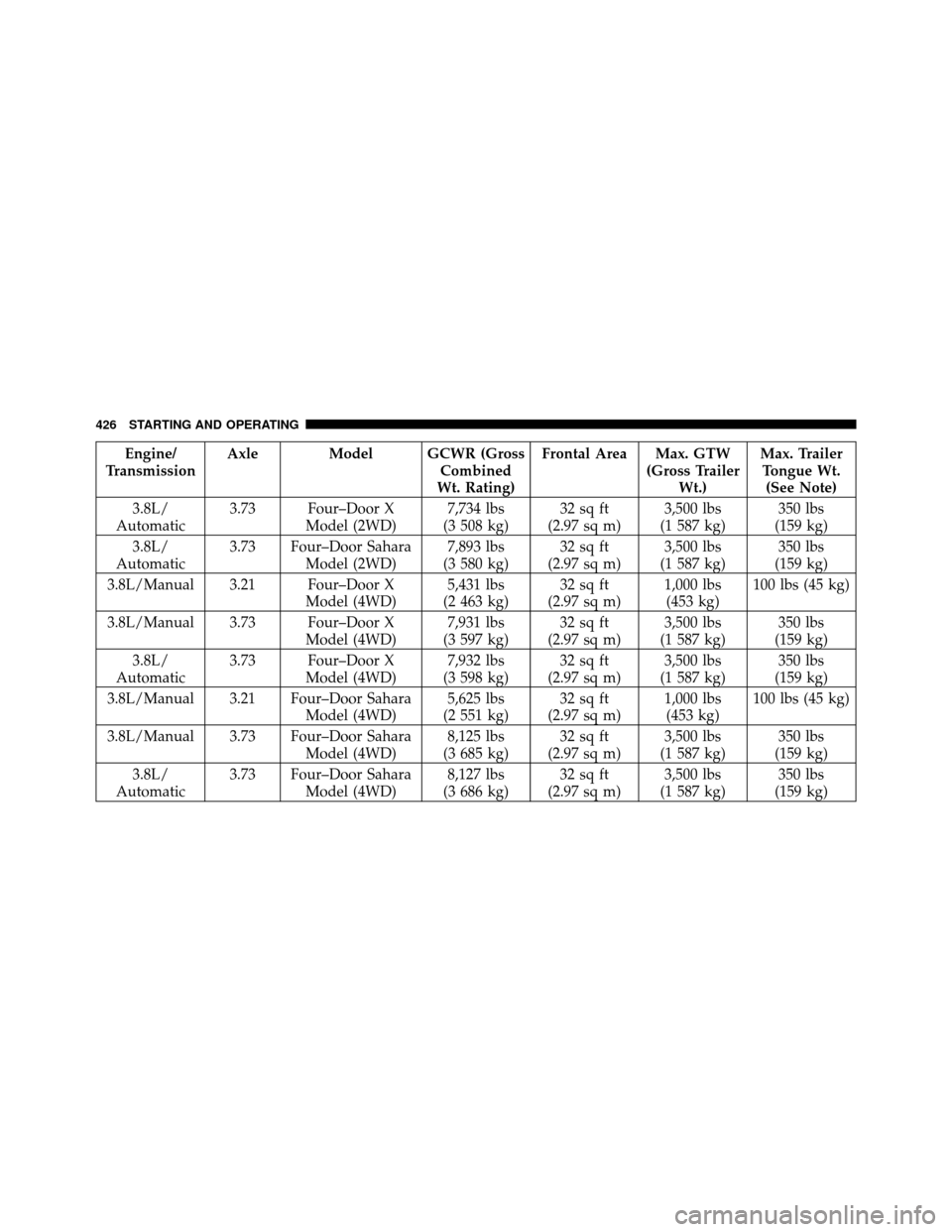
Engine/
Transmission Axle Model GCWR (Gross
Combined
Wt. Rating) Frontal Area Max. GTW
(Gross TrailerWt.) Max. Trailer
Tongue Wt. (See Note)
3.8L/
Automatic 3.73 Four–Door X
Model (2WD) 7,734 lbs
(3 508 kg) 32 sq ft
(2.97 sq m) 3,500 lbs
(1 587 kg) 350 lbs
(159 kg)
3.8L/
Automatic 3.73 Four–Door Sahara
Model (2WD) 7,893 lbs
(3 580 kg) 32 sq ft
(2.97 sq m) 3,500 lbs
(1 587 kg) 350 lbs
(159 kg)
3.8L/Manual 3.21 Four–Door X Model (4WD)5,431 lbs
(2 463 kg) 32 sq ft
(2.97 sq m) 1,000 lbs
(453 kg) 100 lbs (45 kg)
3.8L/Manual 3.73 Four–Door X Model (4WD)7,931 lbs
(3 597 kg) 32 sq ft
(2.97 sq m) 3,500 lbs
(1 587 kg) 350 lbs
(159 kg)
3.8L/
Automatic 3.73 Four–Door X
Model (4WD) 7,932 lbs
(3 598 kg) 32 sq ft
(2.97 sq m) 3,500 lbs
(1 587 kg) 350 lbs
(159 kg)
3.8L/Manual 3.21 Four–Door Sahara Model (4WD)5,625 lbs
(2 551 kg) 32 sq ft
(2.97 sq m) 1,000 lbs
(453 kg) 100 lbs (45 kg)
3.8L/Manual 3.73 Four–Door Sahara Model (4WD)8,125 lbs
(3 685 kg) 32 sq ft
(2.97 sq m) 3,500 lbs
(1 587 kg) 350 lbs
(159 kg)
3.8L/
Automatic 3.73 Four–Door Sahara
Model (4WD) 8,127 lbs
(3 686 kg) 32 sq ft
(2.97 sq m) 3,500 lbs
(1 587 kg) 350 lbs
(159 kg)
426 STARTING AND OPERATING
Page 428 of 554
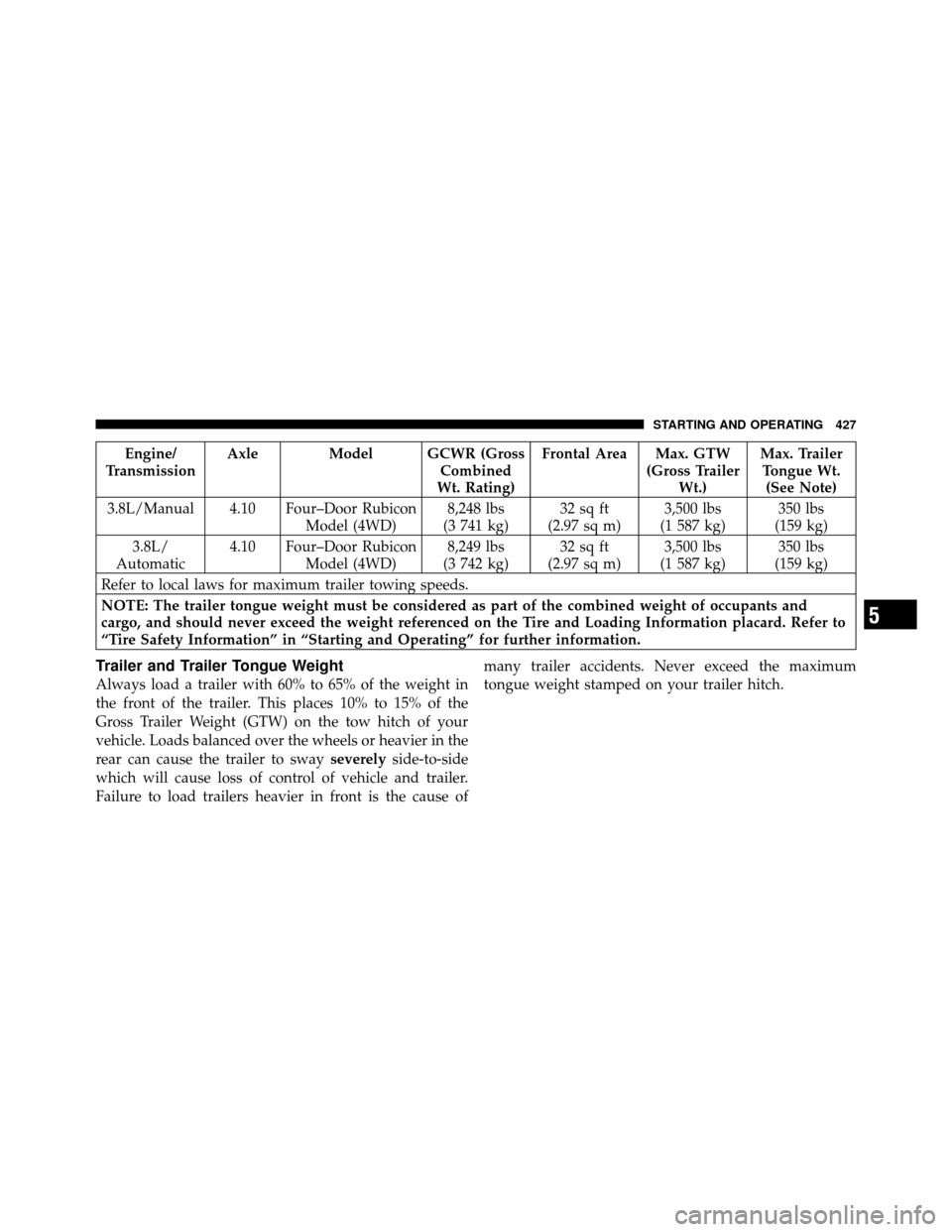
Engine/
Transmission Axle Model GCWR (Gross
Combined
Wt. Rating) Frontal Area Max. GTW
(Gross TrailerWt.) Max. Trailer
Tongue Wt. (See Note)
3.8L/Manual 4.10 Four–Door Rubicon Model (4WD)8,248 lbs
(3 741 kg) 32 sq ft
(2.97 sq m) 3,500 lbs
(1 587 kg) 350 lbs
(159 kg)
3.8L/
Automatic 4.10 Four–Door Rubicon
Model (4WD) 8,249 lbs
(3 742 kg) 32 sq ft
(2.97 sq m) 3,500 lbs
(1 587 kg) 350 lbs
(159 kg)
Refer to local laws for maximum trailer towing speeds.
NOTE: The trailer tongue weight must be considered as part of the combined weight of occupants and
cargo, and should never exceed the weight referenced on the Tire and Loading Information placard. Refer to
“Tire Safety Information” in “Starting and Operating” for further information.
Trailer and Trailer Tongue Weight
Always load a trailer with 60% to 65% of the weight in
the front of the trailer. This places 10% to 15% of the
Gross Trailer Weight (GTW) on the tow hitch of your
vehicle. Loads balanced over the wheels or heavier in the
rear can cause the trailer to sway severelyside-to-side
which will cause loss of control of vehicle and trailer.
Failure to load trailers heavier in front is the cause of many trailer accidents. Never exceed the maximum
tongue weight stamped on your trailer hitch.
5
STARTING AND OPERATING 427
Page 430 of 554
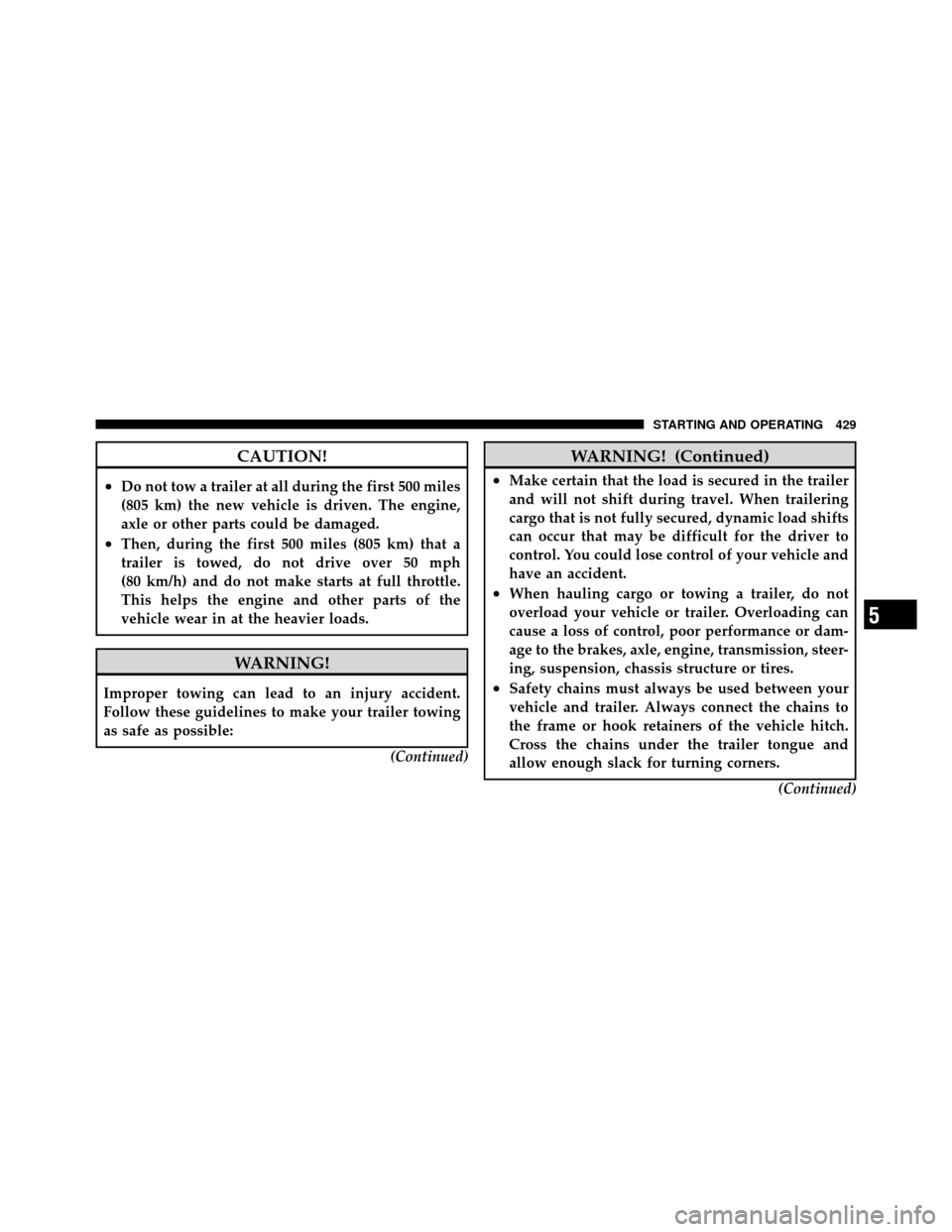
CAUTION!
•Do not tow a trailer at all during the first 500 miles
(805 km) the new vehicle is driven. The engine,
axle or other parts could be damaged.
•Then, during the first 500 miles (805 km) that a
trailer is towed, do not drive over 50 mph
(80 km/h) and do not make starts at full throttle.
This helps the engine and other parts of the
vehicle wear in at the heavier loads.
WARNING!
Improper towing can lead to an injury accident.
Follow these guidelines to make your trailer towing
as safe as possible:(Continued)
WARNING! (Continued)
•Make certain that the load is secured in the trailer
and will not shift during travel. When trailering
cargo that is not fully secured, dynamic load shifts
can occur that may be difficult for the driver to
control. You could lose control of your vehicle and
have an accident.
•When hauling cargo or towing a trailer, do not
overload your vehicle or trailer. Overloading can
cause a loss of control, poor performance or dam-
age to the brakes, axle, engine, transmission, steer-
ing, suspension, chassis structure or tires.
•Safety chains must always be used between your
vehicle and trailer. Always connect the chains to
the frame or hook retainers of the vehicle hitch.
Cross the chains under the trailer tongue and
allow enough slack for turning corners.(Continued)
5
STARTING AND OPERATING 429